It was an ear-splitting, venomous bark of biblical proportion. My neck snapped hard right. Three metres away and advancing rapidly was an Australian Fur Seal, 150kg of terror, mouth and neck twisted in fury, teeth exposed. Unhappy. Extremely unhappy. With me.
I staggered backwards – incapable of either fight or flight, succumbing to pure, paralysing fear. Anemone-waving my trekking poles as a pathetic recourse for survival, prophecies of doom screaming, my body overtaken by adrenaline… and the seal paused. Though still vociferous in making its displeasure known, its hesitation allowed me to scramble out of the war zone.
Snakes, dingoes, goannas, whales, dolphins, birds aplenty (feral pigs and deer, too) – sure. To be expected. But an outraged seal in close quarters giving me a right royal bollocking for invading its personal space? That, I confess, was not a consideration for my nine-day 165km solo saunter through a combined Gippsland Wilderness Coast Walk and Cape Howe-Nadgee Wilderness Walk – beginning at Bemm River’s Ocean Beach in Victoria and ending at Merrica River Crossing in NSW’s Nadgee Nature Reserve, during September and October, 2018.
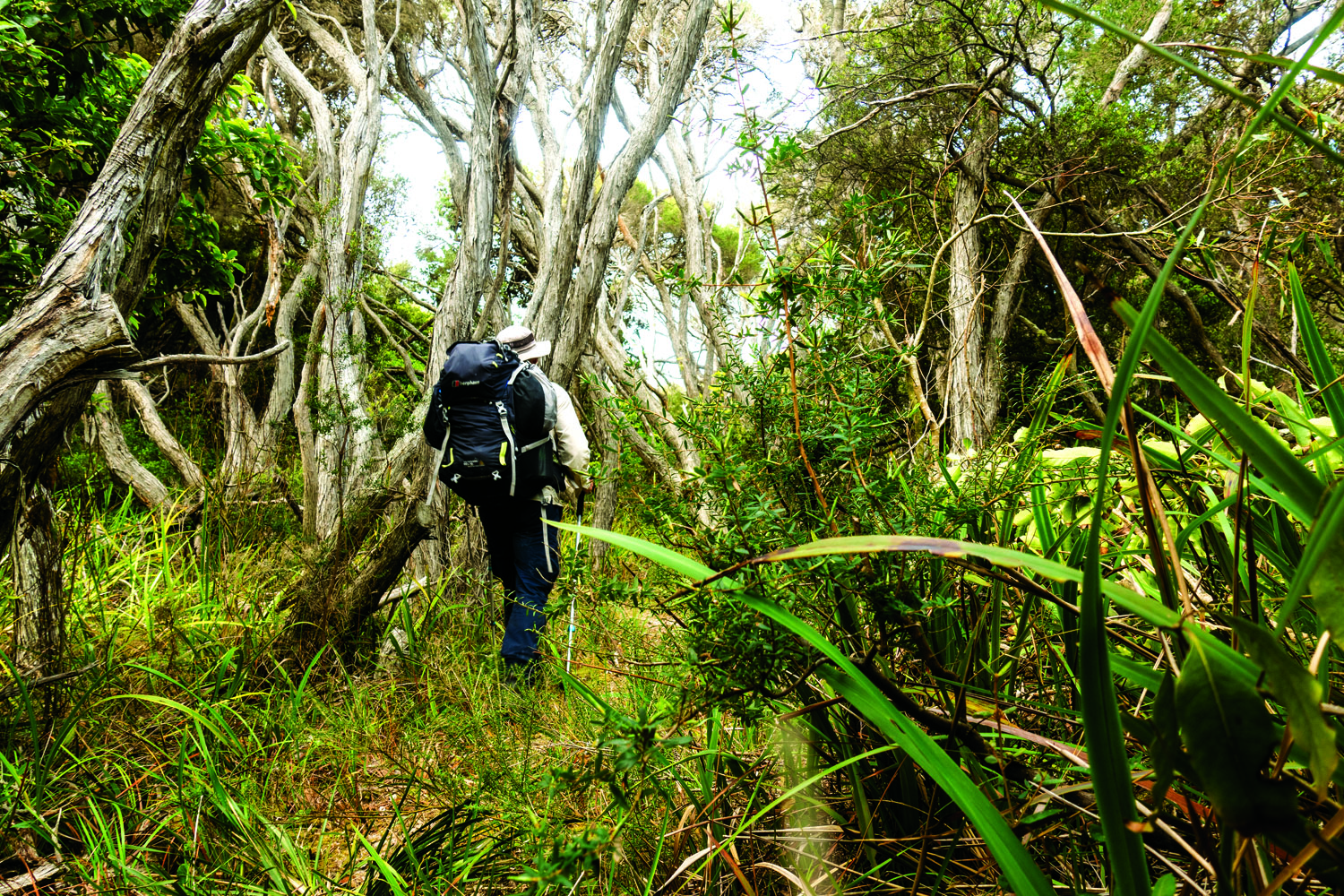



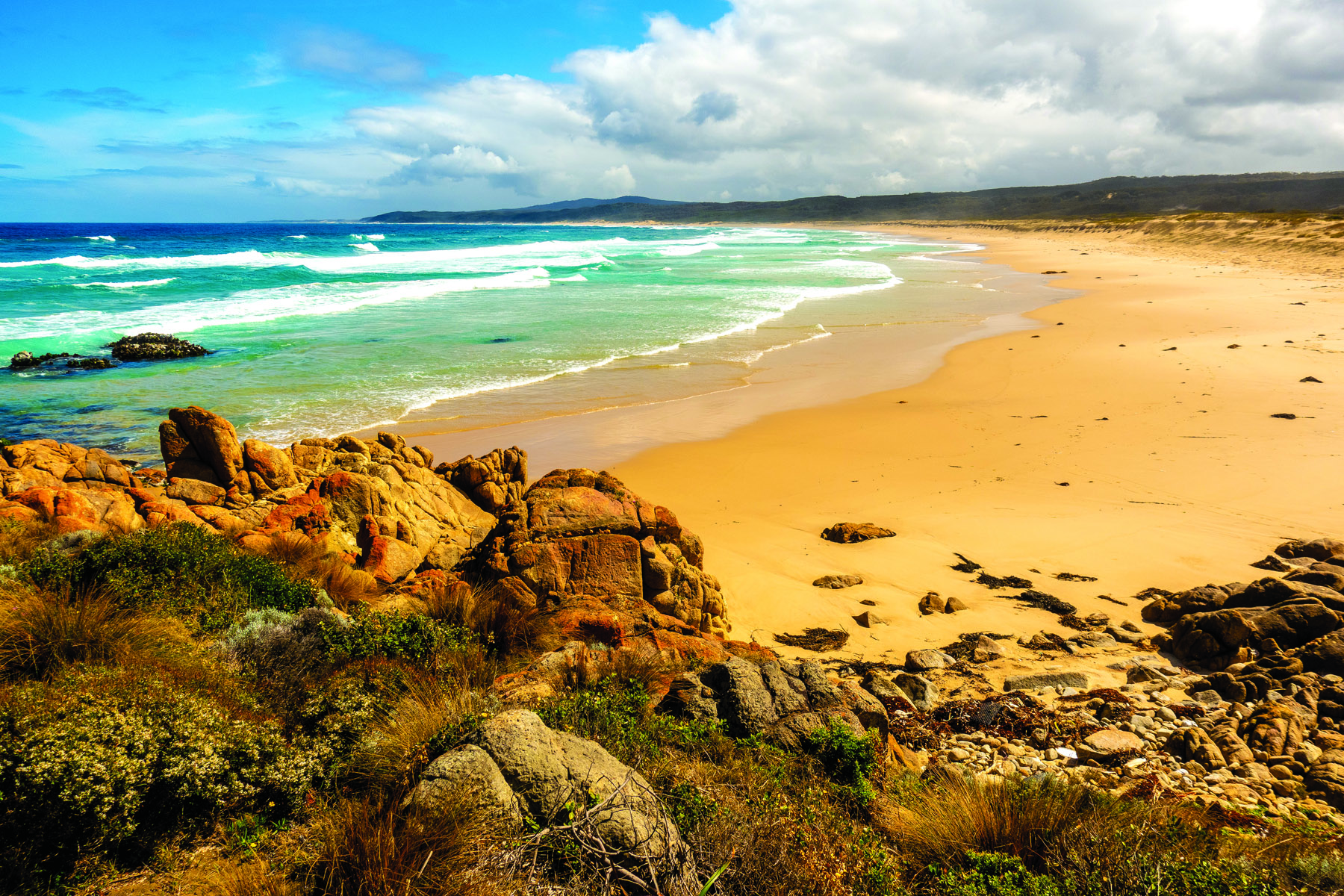


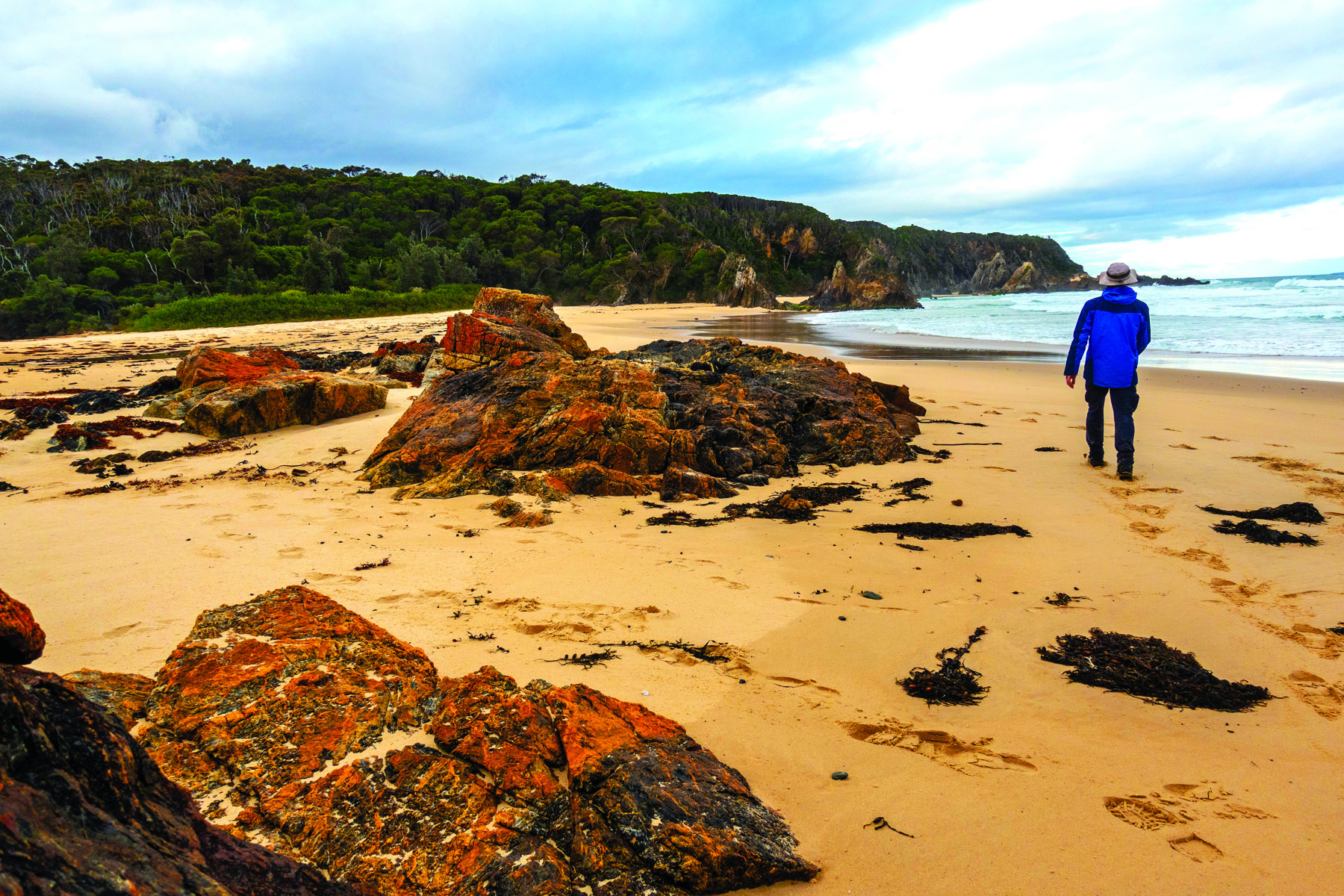
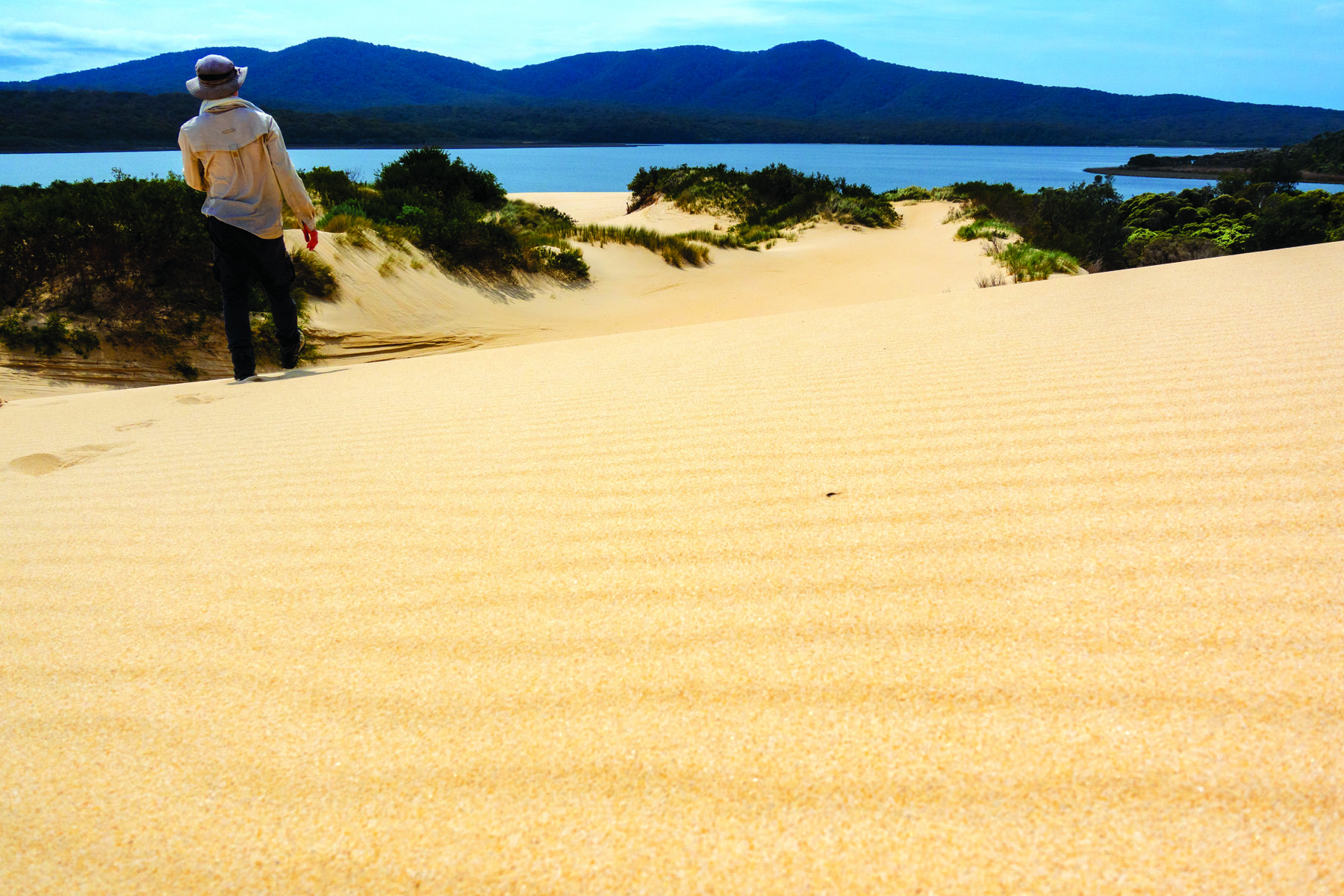
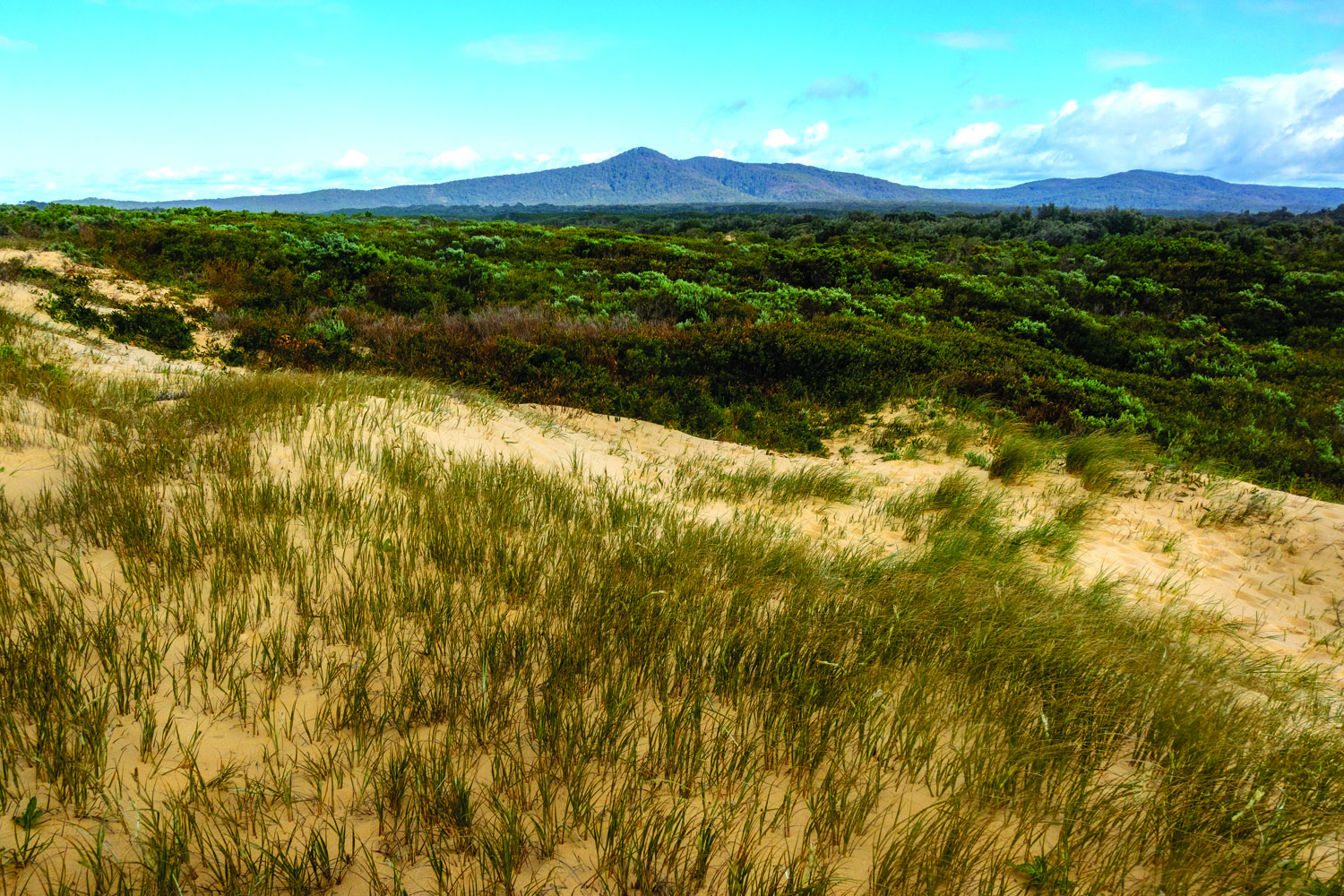
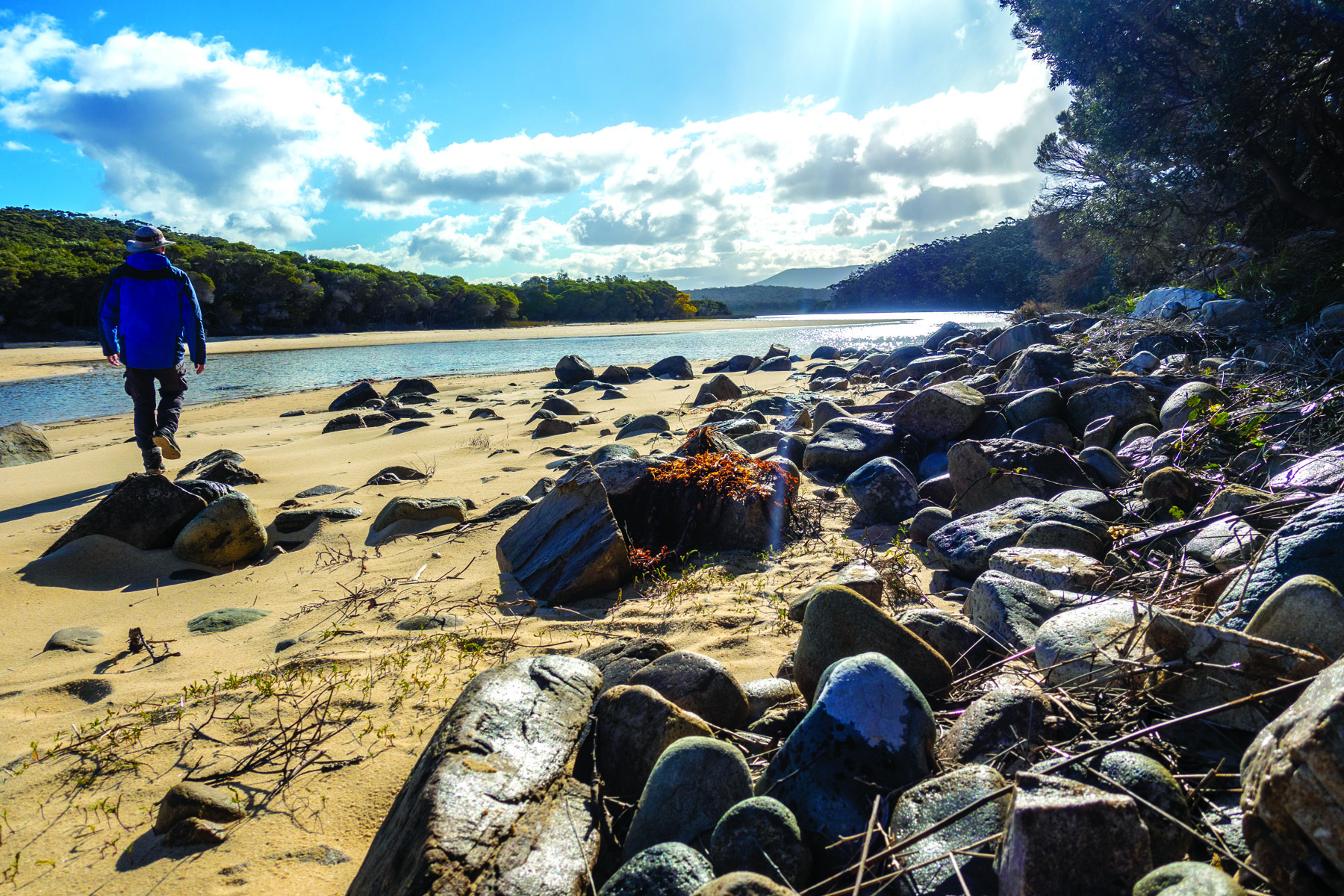
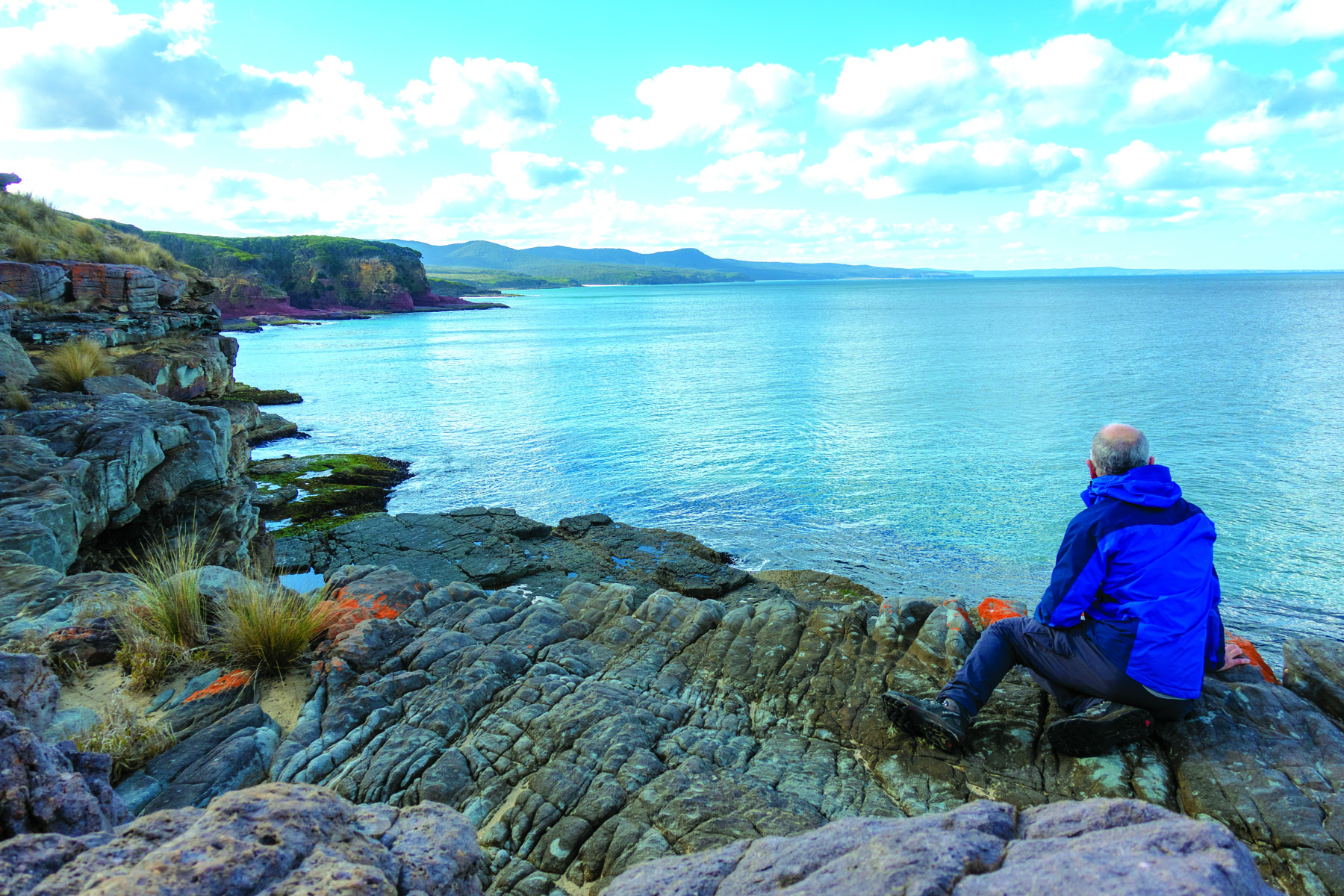
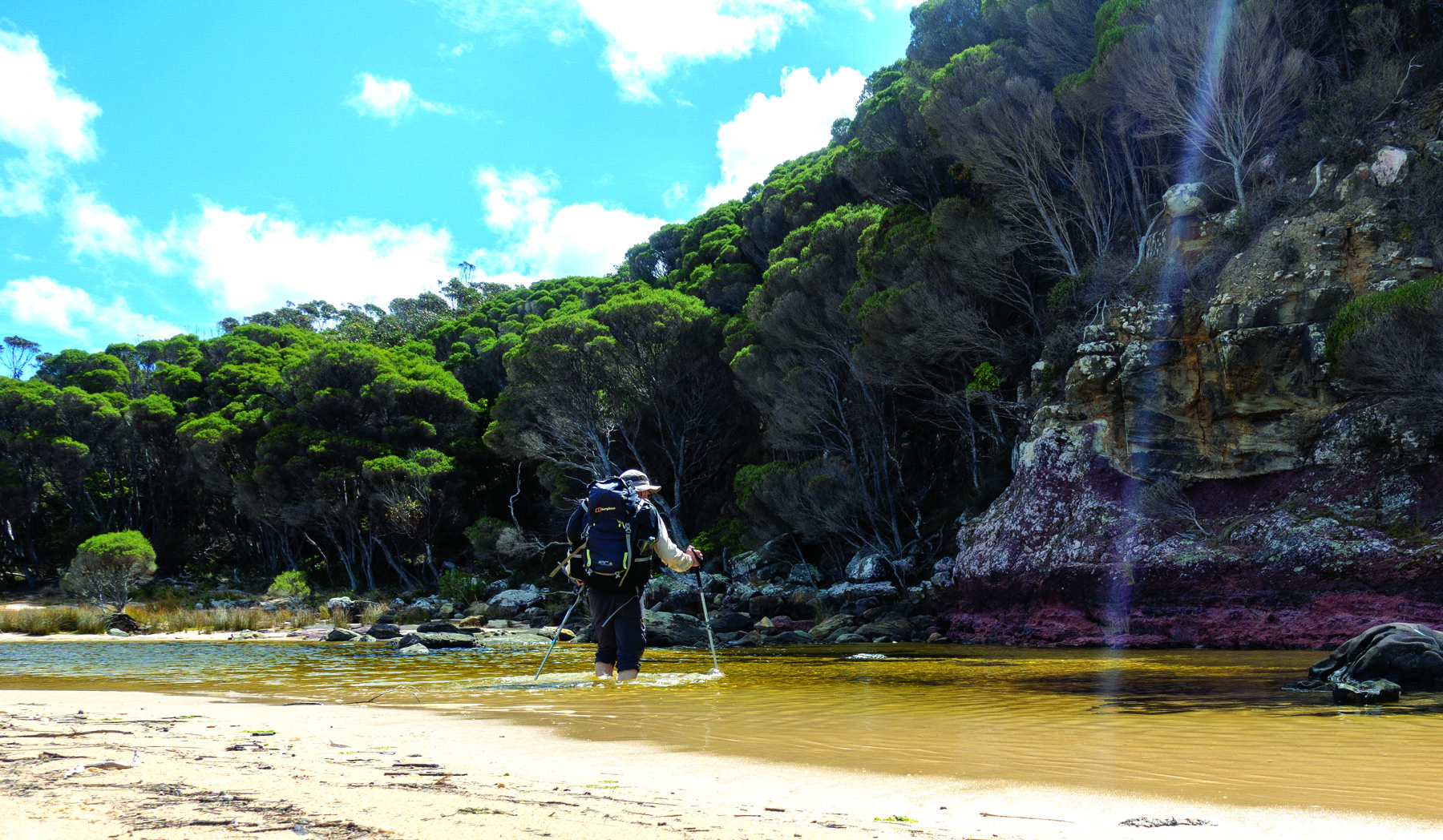
SAUNTERING TO THE SURF
This is a walk dominated by the coast. There’s beach... lots of beach. And the constant soundtrack of the surf – from boom crash opera to gentle whispers. Even on inland diversions there was no silence; instead, birdlife singing and wind breathing through the forest, scrub and heath.
There are massive, mobile dune systems (in collusion with winds around Cape Howe that made it a battle to stay vertical); headlands, coves, and lengthy rock outcrops; inlets, rivers, lagoons and lakes; and extensive coastal heaths. The track you are on? Well, sometimes it’s barely there, and frequently non-signposted – often deliberately so, as the two states’ national parks organisations adhere to the wilderness theme.
‘Wilderness’ is right. I only crossed paths with two other walkers in the 165km I covered. And, does it get more wild than finding yourself with a trackside seat to a humpback whale race? At one point, in Cape Howe, I saw over 50 in the space of 30 minutes – as the super mammals, breaching at will, cut the corner heading south with their newly minted calves in tow.
CHALLENGES ON THE TRAIL
The dream driving this walk was inspired by a long-ago seen collection of Croajingolong National Park photos. They showed off its trademark orange lichen-covered rocks, its dunes and its inlets. Packed with contrast and drama, much of it only accessible by foot and definitely idyllic – my imagination was ensnared.
Then, I became aware of the Nadgee-Howe Wilderness Area and the track through this even wilder domain. I found the idea of combining the two walks irresistible and, well, the common sense choice (my wife may disagree).
This was a barrier-breaking walk for me: more than doubling the duration and length of the longest multi-day hike I’d previously undertaken. Doing it solo was straightforward enough. Aside from a swollen Tibialis Anterior muscle and tendon I obtained just 10km in, the biggest challenge was navigation. There is a lack of signage, which walkers are certainly warned about in the national parks’ literature. Add to that that some tracks cannot be seen – for example, on sections of the three Nadgee moors, there are extended periods where you can’t see your feet as the vegetation hedging the ‘track’ is so luxuriant. The topo maps for Nadgee are a must, but even they aren’t fully reliable. I was thrown by tracks not appearing where indicated, so perhaps since their printing the bush has reclaimed territory. Or maybe I’m blind, which, given I nearly walked into a large seal, is a reasonable suggestion.
Previous walkers have done their best to mark, in Nadgee, what I found to be the trickiest of the nav dilemmas, that of finding the start of the damn tracks coming off the beaches. Still, when going in a northerly direction through Nadgee, at least, the exit points were difficult to determine. Invariably a precursor had put up some timber to mark the exit point, but sometimes it would take a couple of patrols up and down the beach to find it. Bush bashing from the wrong spot until you find the track is an option (and it’s one I did employ!), but the heath and scrub is a monster so it’s hard yards.
All part of the wild world fun.
THE WONDER OF THE WILDERNESS
This walk is rife with wonder: geography; animals, birds, marine life; vegetation; ocean and sky-scapes. Croajingolong and Nadgee possess an astonishing biodiversity. In Nadgee alone 48 native mammal, 216 bird, 28 reptile and 16 amphibian species have been identified. Croajingolong counts over 1,000 plant and 306 bird species amongst its ranks, with the latter number accounting for – incredibly – about a third of Australia’s total bird species. The ocean’s pristine waters are frequented by turtles, sea snakes, orcas and Little Penguins (Gabo Island, just off the coast, supports a breeding colony of about 20,000 pairs).
I was fortunate enough to see a locally cherished endangered species of bird – the ground parrot – on heaths in both Croajingolong and Nadgee. I was probably most excited, however, by seeing a yellow-billed spoonbill, fossicking for some breakfast at Wingan Inlet, as I was ferried across the waters, prince-like, by a friendly car-camper who saved me a deep, bracing wade.
Another highlight was when, squinting up through a sunshine striped back-of-beach glade by Nadgee Lake, I met the implacable gaze of a dingo – pale, sandy-coloured and perfectly camouflaged to its environment – peering down at me. Our eyes locked, scrutinising, neither moving. Then, satisfied, it melted away, as if a figment of my imagination.
This diversity and richness have been recognised by UNESCO, which has designated this area a Biosphere Reserve. The diversity is not just the result of these areas having had only a light human touch imprinted on them. Plants reach their southern and northern limits in this ‘crossover’ region. Around Cape Howe the warmer waters from eastern Australia mix with cooler southern waters, which has created an environment rich in nutrients and high in productivity. At Cape Howe, the coast changes from broadly east-west to north-south, and the coastal processes shift from wind-dominated to wave-dominated, impacting on the nature of the coastline and, hence, its biological inhabitants. And, finally, as with any coastal and/or estuarine environments, the marine, terrestrial, intertidal and riparian dimensions all influence each other, creating complex biological interdependencies.
The only possible downside of all of this is that it can take some very long beach walks to reach the most awe-inducing locations. But this is one reason why it’s wilderness, after all. To have it any other way would not only remove the solitude, but it would compromise the wilderness and its considerable purity.
Sadly, at many locations purity was undermined by mankind’s polluting habits. There was general societally-generated rubbish from who knows where, maritime industry flotsam, and, most disturbing of all, bushwalker detritus – combining to form enough evidence of our species’ dirty hand to motivate any sensible person to keep access to these areas as difficult as possible. The #keepitremote campaign starts here.
WALKING IN A DREAM
As a sea-bound walk, the wind is ever-present: sometimes an affliction, sometimes a comfort. At times a gale pushed me forwards, at the same time flinging pellets of rain into my face and roaring into my ear. In the early evenings it helped keep mosquitoes at bay. Sky-high, it entertained by sculpting clouds.
The wind was one of the walk’s dynamic components – an irrepressible ants-in-the-pants child – congenitally incapable of staying still. It was a companion of sorts, one to take note of and work with, not least when a late afternoon squall was blustering off the ocean and a tent needed to be pitched. The ocean and its tides and waves, as well as the mighty dunes, were other very visible aspects of the dynamic environment.
The beaches are enlivened and broken up by a parade of headlands and rocky outcrops, which at times are a marathon crossing (for example, Clinton Rocks offers over one kilometre of obstruction course granite to negotiate). Offered two choices for the traverse, I learnt my lesson early and opted for the rocks rather than the gnarly, impassable heath crouching malevolently at their rear.
Of all the nine days, probably the most astonishing one was that bookended by the beatific campsites at the lagoon at Lake Wau Wauka’s outfall in far east Croajingolong and the river setting of Nadgee Beach. It starts with a mixture of a difficult sand ridge traverse and easier ocean-side walk. A rock-strewn promontory butting out into the ocean provides the first views of Cape Howe, spumes of salt spray shearing off from an onshore break.
And then there they are… Cape Howe’s magnificent dune systems. You see impressive examples of this signature characteristic of the walk at Thurra River and Lake Barracoota. They are but a portent, however, of those at Cape Howe. Here, massive, mobile systems extend for kilometres in astonishing lunar-like splendour. You get an idea of the scale of the dunes from maps, but there is something uncanny, something that knocks you off-kilter, when standing in the middle of them at Cape Howe.
The dunes rise to dizzying heights off the beach and inland heath. Beyond their sprawl, there is the hinterland, and views across to Gabo Island with its pretty pink (really – it’s made from the island’s endemic granite) on show.
The vastness of the sand dunes and the blinding light they radiate fools you, by sucking up perspective. You think you are on a planed surface, but then huge sand gulches appear. The sand’s density is also surprising, but where it falls dramatically to the ocean it is known for being less solid, and treacherously so, with walkers reportedly sinking up to their hips.
This happened to me, not here but in the Tamboon Inlet’s outfall. Spewy sand opened its maw, from which muscular arms materialised. I was pulled down to my thighs, a mild panic electrifying me until I could secure some purchase with my arms, arrest the decline, and extract my mulish pack-laden body from the mire.
A PARTING GIFT
The desolation of leaving Newtons Beach, a setting of riveting beauty and peacefulness, on the walk’s final morning was, and still is, palpable. Separation from the coast, for the final time, meant my experience was soon to shut down.
As with any walk of this duration, I’d begun to sink into the environment, forming a relationship with it, one that frayed at times, but ultimately one that nurtured a brilliant glow within me.
The desolation of separation was magnified by the camp’s situation which, for the only time on this walk, included there being zero evidence of humanity. No walker or fisherman or general human flotsam; no pulled together planks for seats; no fire-charred wood (I camped at the northern end of the beach in a narrow rock gully, folded into the bush’s embrace). There was just sand, rock, trees, kelp, some birds, me and my kit.
The morning sky yawned blue and cloudless. Its wind was tender on the cheek. The calm was a heartbreaker. It was a slow camp deconstruct indeed.
I’ve been here before; the relationship’s final embrace is often the most ardent, then you are cast away, left with crowded, full-blooded memories – ingredients in a complex emotional and psychological stew.
I took one last, reluctant look, then receded into the forest, rising high and distant, the coast and its wind and surf-driven conversation cruelly waning, but with my memories safe and secure, wrapped in a satisfied, weary smile.
BOOKING IN
It is necessary to book passage through many parts of this walk in both states. Only 20 people are allowed in the Nadgee wilderness, for instance, at any one time.
You can find out more at the Parks Victoria website and the NSW National Parks and Wildlife Service website.





